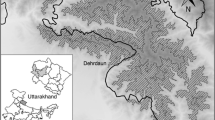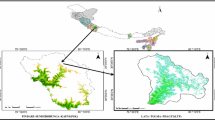Abstract
Forest structure and regeneration were studied along the altitudinal gradient in the Binsar Wildlife Sanctuary of Uttarakhand Himalaya in India. Stratified random sampling of tree species was done by placing minimum 15 quadrats of 10 × 10 m at each aspect and altitude. The results reveal that along the altitudinal gradient there were three types of forest communities in the Sanctuary viz., chir pine (Pinus roxburghii), oakchir pine (Quercus leucotrichophora and Pinus roxburghii) and oak (Quercus floribunda and Quercus leucotrichophora). Rhododendron arboreum, Cornus macrophylla and Lyonia ovalifolia were main associates of these forest communities. The oak forests had larger shrub population as compared to chir pine. Myrsine africana was the most dominant shrub across the altitudinal gradient, whereas few shrub species were restricted to a certain altitudinal range. The regeneration of chir pine was best at lower altitude on south and east aspects, which indicates that it mostly regenerates on warm and dry slopes. In general, the regeneration potential in most of the tree species declines with the altitude. The density of saplings and seedlings also represented the dominant species at each altitudinal range, which indicates the cyclic regeneration of forests in the Sanctuary area.
Similar content being viewed by others
References
India’s Forest, Central Forestry Commission, Ministry of Agriculture, Government of India, 1980.
Carpenter, C., The Environmental Control of Plant Species Density on a Himalayan Elevation Gradient, J. Biogeogr., 2005, vol. 32, pp. 999–1018.
Champion, H.G., A Preliminary Survey of Forest Types of India and Burma, Indi. For. Rec. (New Series), 1936, vol. 1, pp. 1–286.
Champion, H.G. and Seth, S.K., A Revised Survey of the Forest Types of India, New Dehli: Govt. of India, 1968.
Cottam, G., The Phytosociology of an Oak Woodland in Southern Wisconsin, Ecology, 1949, vol. 30, pp. 271–287.
Curtis, J.T., The Vegetation of Wisconsin: An Ordination of Plant Communities, Madison, WI: Univ. of Wisconsin Press, 1959.
Curtis, J.T. and McIntosh, R.P., The Interrelations of Certain Analytic and Synthetic Phytosociological Characters, Ecology, 1950, vol. 31, pp. 434–455.
Gansser, A., Geology of Himalaya, London: Wiley, 1964.
Gupta, R.K., Climatic Conditions and Flowering Season in Outer Himalayas at Nainital, Ind. Forester, 1961, vol. 87, no. 3, pp. 189–191.
Kala, C.P., Indigenous Uses and Structure of Chir Pine Forest in Uttaranchal Himalaya, India, Int. J. Sustain. Dev. World Ecol., 2004, vol. 11, no. 2, pp. 205–210.
Kala, C.P. and Mathur, V.B., Patterns of Plant Species Distribution in the Trans-Himalayan Region of Ladakh, India, J. Veg. Sci., 2002, vol. 13, no. 6, pp. 751–754.
Kala, C.P. and Uniyal, V.K., Forest Vegetation along an Altitudinal Gradient in the Valley of Flowers National Park and Its Vicinity, Western Himalaya, Ann. Forestry, 1999, vol. 7, no. 1, pp. 60–69.
Kershaw, K.A., A Survey of the Vegetation in Zaria Province, N. Nigeria, Vegetatio, 1968, vol. 15, pp. 244–268.
Knight, D.H., A Distance Method for Constructing Forest Profile Diagram and Obtaining Structural Data, Trop. Ecol., 1975, vol. 4, pp. 89–94.
Kumar, A. and Ram, J., Anthropogenic Disturbances and Plant Biodiversity in Forests of Uttaranchal, Central Himalaya, Biodiv. Conserv., 2005, vol. 14, pp. 309–331.
Lovett, J.C., Elevational and Latitudinal Changes in Tree Associations and Diversity in the Eastern Arc Mountains of Tanzania, J. Trop. Ecol., 1996, vol. 12, pp. 629–650.
Majila, B.S., Phytosociology, Biomass Structure and Primary Productivity of Oak-Pine Forest of Kumaun Himalaya, Ph.D. Thesis, Nainital: Kumaun University, 1992.
Majila, B.S., Joshi, G.C., and Kala, C.P., Patterns in Litter Fall and Litter Decomposition along an Altitudinal Gradient in the Binsar Wildlife Sanctuary, Central Himalaya, Int. J. Sustain. Dev. World Ecol., 2005, vol. 12, no. 2, pp. 205–212.
Misra, R., Ecology Work Book, Oxford: IBH, 1968.
Mueller-Dombois, D. and Ellenberg, H., Aims and Methods of Vegetation Ecology, New York: Wiley, 1974.
Philips, E.A., Methods of Vegetation Study, Henry Holt and Company, 1959.
Pocs, T., Vegetation Mapping in the Uluguru Mountains, Tanzania, East Africa. Boissiera, 1976, vol. 24, pp. 477–498.
Ralhan, P.K., Saxena, A.K., and Singh, J.S., Analysis of Forest Vvegetation at and around Nainital in Kumaun Himalaya, Proc. Natl. Sci. Acad., 1982, B vol. 48, pp. 121–137.
Rana, B.S., Verma, K.R., and Pandey, N., Analysis of Forest Vegetation at Siahi Devi Hills of West Almora Division in Kumaun Himalaya, Ind. Forester, 1985, vol. 111, no. 9, pp. 745–759.
Risser, P.G. and Rice, E.L., Diversity in Tree Species in Oklahoma Upland Forests, Ecology, 1971, vol. 52, pp. 876–880.
Ronnells, K. and Laumonier, Y., Species Diversity Structure Analysis at Two Sites in the Tropical Rain Forest of Sumatra, J. Trop. Ecol., 2000, vol. 16, pp. 253–270.
Sagar, R., Raghubanshi, A.S., and Singh, J.S., Tree Species Composition, Dispersion and diversity along a Disturbance Gradient in a Dry Tropical Forest Region of India, For. Ecol. Manag., 2003, vol. 186, nos. 1–3, pp. 61–71.
Saxena, A.K. and Singh, J.S., A Phytosociological Analysis of Woody Species in Forest Communities of a Part of Kumaon Himalaya, Vegetatio, 1982, vol. 50, pp. 3–22.
Shannon, C.E. and Weaver, W., The Mathematical Theory of Communication, Urbana, IL: Urbana Univ. Press, 1963.
Simpson, E.H., Measurement of Diversity, Nature, 1949, vol. 163, p. 688.
Singh, S.K., Studies on Biomass, Phytosociology and a Productivity of Siahi Devi Forest of West Almora Division, Kumaun Himalaya, PhD. Thesis, Nainital, India: Kumaun University, 1989.
Singh, J.S., The Biodiversity Crisis: A Multifaceted Review, Curr. Sci., 2002, vol. 82, pp. 638–647.
Singh, J.S. and Singh, S.P., An Integrated Ecological Study of Eastern Himalaya with Emphasis on Natural Resources: Project Report, Nainital, India: Kumaun University Press, 1984.
Singh, J.S. and Singh, S.P., Forest Vegetation of the Himalaya, Bot. Rev., 1987, vol. 53, pp. 80–192.
Tripathi, S.K., Verma, K.R., and Upadhyaya, V.P., Analysis of Forest Vegetation at Kasar Devi Hills of North-West Almora Division in Kumaun Himalaya, Proc. Ind. Acad. Sci. (Plant Sci.), 1987, vol. 97, no. 3, pp. 265–276.
Uprety, N., A Study on the Phytosociology and State of Regeneration of Oak Forest at Nainital, Ph.D.Thesis, Nainital, India: Kumaun Univ., 1982.
Valdia, K.S., Kumaun Ki Khaniz Sampada: Kuch Sambhawanayen, Uttarakhand and Bhartiya, 1976, vol. 1, no. 2, pp. 1–6.
Vetaas, O.R. and Grytnes, J.-A., Distribution of Vascular Plant Species Richness and Endemic Richness along the Himalayan Elevation Gradient in Nepal, Global Ecol. Biogeogr., 2002, vol. 11, pp. 291–301.
Youngblood, A., Max, T., and Coe, K., Stand Structure in East Side Old Growth Ponderosa Pine Forest of Oregon and Northern California, For. Ecol. Manag., 2004, vol. 199, nos. 2–3, pp. 191–217.
Wangda, P. and Ohsawa, M., Gradational Forest Change along the Climatically Dry Valley Slopes of Bhutan in the Midst of Humid Eastern Himalaya, Plant Ecol., 2006, vol. 186, pp. 109–128.
Whittaker, R.H., Dominance and Diversity in Land Plant Communities, Science, 1965, vol. 147, pp. 250–260.
Whittaker, R.H. and Woodwell, G.M., Structure, Production and Diversity of an Oak-Pine Forest at Brook Haven, New York, J. Ecol., 1969, vol. 57, pp. 155–174.
Zobel, D.B. and Singh, S.P., Himalayan Forests and Ecological Generalizations, Bioscience, 1997, vol. 47, pp. 735–745.
Author information
Authors and Affiliations
Corresponding author
Additional information
The article is published in the original.
Rights and permissions
About this article
Cite this article
Majila, B.S., Kala, C.P. Forest structure and regeneration along the altitudinal gradient in the Binsar Wildlife Sanctuary, Uttarakhand Himalaya, India. Russ J Ecol 41, 75–83 (2010). https://doi.org/10.1134/S1067413610010157
Received:
Published:
Issue Date:
DOI: https://doi.org/10.1134/S1067413610010157




